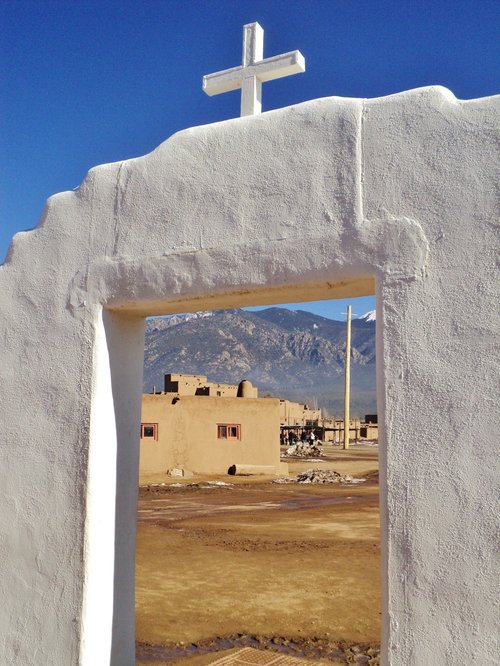On the morning of November 30th, after a short drive from Santa Fe, my wife and I reached Taos Pueblo. I knew all the particulars about price, pictures, and the general rules. However, I was pleased to learn the photo policy has changed. There are no longer any restrictions or fees about general use of cameras within the Pueblo. A guided tour is optional, but is certainly worth it. You can explore the pueblo at your leisure before or after.
There has also been other positives for the Taos Pueblo community in recent years. The pueblo has seen a recent increase of inhabitants living full-time inside the pueblo. Restricted portions of the pueblo are primarily areas that lead to 4 traditional kivas that are only accessible to tribal members. There is also a elementary school in the rear of the North section of Taos Pueblo. This school does teach the local language of Northern Tiwa.
The Taos Pueblo used to be guarded by a more defensive wall, but today it is a very short enclosure. The North side of the Pueblo (Hlaauma) is divided by the Red Willows Creek from the South side (Hlaukkwima). Most of the pictures tend to be of Hlaauma, but using small bridges one can visit the older Hlaukkwima area of the pueblo. (Up to 1000 years old) My picture is of this area, one can see the general condition of this area is slightly more worn down by time.

The 19th century church near the entrance of the pueblo is a common, but elegant mission. There are several far older and more photographed missions throughout New Mexico. The original is located near the cemetery and was ruined during the Pueblo revolt in the early 19th century.
Most residents within the pueblo make a living as craftsman and artisans. Some homes also sell various food and drinks, such as fry bread. These "shops" are generally located in the front portion of the home, which traditionally was used for the kitchen and storage, the living quarters remain separated. It should be noted, the Pueblo is NOT overly commercialized and these shops are almost indiscernible from other homes, except for an "open" sign in the door and perhaps a modest sign.
The entrance for the pueblo is $25 and despite a small minority of visitors being unhappy by this, this seems reasonable. If the pueblo wants to be economically viable there needs to be an admission fee. This also helps control visitors. Foreigners expecting Taos residents to be garnered in "traditional" clothes will be disappointed, but this is an unrealistic and largely pointless expectation. Native Americans are not interested in being "displayed" in such a manor. Traditional clothing is reserved for ceremonies, feasts, and for the annual events held at the pueblo. It should be noted that all US Native Reservations follow a similar practice. The gaudy expectation that the locals should be wearing what their ancestors wore 100 plus years ago is rooted in harmful stereotypes.
There are 19 pueblos in New Mexico, Taos being the most Northern and the best preserved. Perhaps the 2nd most notable pueblo is Acoma, also known as "Sky City". This pueblo is a national historic landmark and it beautifully located on a mesa fairly high up. Taos Pueblo is truly an amazing place. I have to disagree somewhat with other reviewers. I felt Taos Pueblo was equally worthwhile to visit in comparison to Chaco or Mesa Verde. The pueblo and the nearby mountains (particularly in Winter) are very photogenic. The shops are also worth stopping in. The quality of the wares are high, and store owners are polite.
In the Southwest there are 3 Puebloan world heritage sites. Mesa Verde, Chaco, and Taos Pueblo. It is my view that these 3 WHS are some of the most outstanding cultural sites in the United States. Moreover, I believe there are other sites in the region deserving of world heritage status.
More on
Comments
No comments yet.
